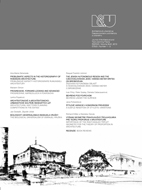VÝZNAM GEOMETRIE PRAVOUHLÉHO TROJUHOLNÍKA PRE TEÓRIU PROPORCIE V ARCHITEKTÚRE: ZLATÝ REZ A JEHO UPLATNENIA
IMPORTANCE OF THE RIGHT-ANGLED TRIPLET GEOMETRY FOR THE THEORY OF PROPORTION IN ARCHITECTURE: THE GOLDEN RATIO AND ITS APPLICATIONS
Author(s): Stanislav Darula, Richard KittlerSubject(s): Cultural Essay, Political Essay, Societal Essay
Published by: Historický ústav SAV, v. v. i.
Keywords: The gold ratio; proportion; space sensation; shape sensation
Summary/Abstract: The settled life-style in the first centres of civilisation had to satisfy new needs for safe and functional structures regarding town plans, as well as dwelling organisation within restricted a fortified. The street network logically influenced the rectangular plans of houses and monumental buildings like temples, ziggurats and pyramids. Similarly, the water supply and sewage networks with bathing pools, like in Mohenjo-daro in the Indus River valley, document such tendencies. The hygienic and cultural needs in crowded trade and capital centres required by noblemen, priests, working and trading parties were successfully met in rectangular urban schemes culminating in the Roman camp plans or in Greek and Roman atrium houses as recommended by Vitruvius. However, the orientation of streets and buildings toward cardinal points and their surveying set was dependent on the knowledge of right-angled triangles in Sumer and Egypt, e.g. with sides in ratio 3 : 4 : 5 etc. The aesthetic preference evolving towards the golden ratio or section combined the search for the abscissa division with the rectangular shape determined by diagonals, as well as intersecting triangles. Consequently, such a search for the most pleasing images was finalised by the socalled Kepler triangle as well as by the Pacioli & da Vinci scheme of human measures and in modern times through Corbusier’s Modulor. These dimensional proportions were tested later in psychophysical experiments by Fechner, who provided serious psychological proofs of the human preference for the golden section as the relatively most pleasing choice from different rectangular shapes. Unfortunately, current research into the evaluation of architectural proportions, making use of recent real compositions grounded in the methods and abstract tests of architectural psychophysics is still lacking. Thus it is highly worthwhile to initiate investigations and measurement methods evaluating the visual sensations and perceptions of architectural forms and proportions under various daylight conditions and as well as night-time illumination.
Journal: Architektúra & Urbanizmus
- Issue Year: 47/2013
- Issue No: 1-2
- Page Range: 122-133
- Page Count: 12
- Language: Slovak

